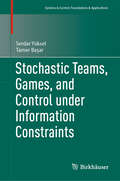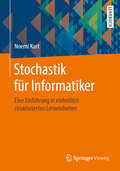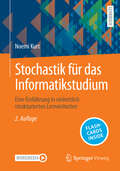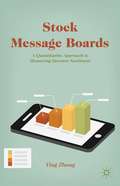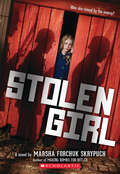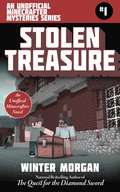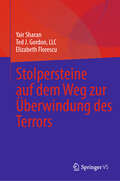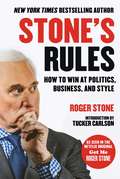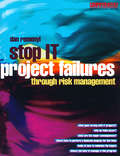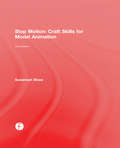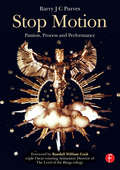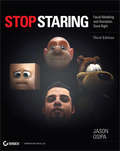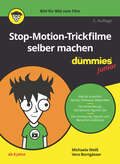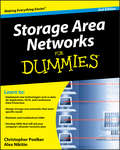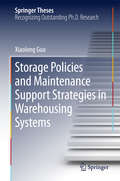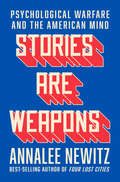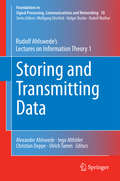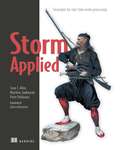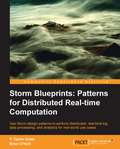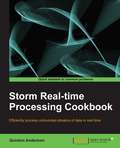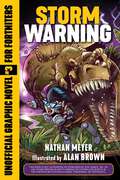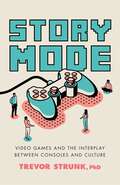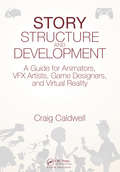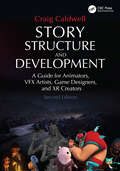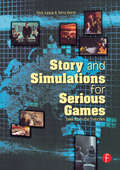- Table View
- List View
Stochastic Teams, Games, and Control under Information Constraints (Systems & Control: Foundations & Applications)
by Tamer Başar Serdar YükselThis monograph presents a mathematically rigorous and accessible treatment of the interaction between information, decision, control, and probability in single-agent and multi-agent systems. The book provides a comprehensive and unified theory of information structures for stochastic control, stochastic teams, stochastic games, and networked control systems.Part I of the text is concerned with a general mathematical theory of information structures for stochastic teams, leading to systematic characterizations and classifications, geometric and topological properties, implications on existence, approximations and relaxations, their comparison, and regularity of optimal solutions in information. Information structures in stochastic games are then considered in Part II, and the dependence of equilibrium solutions and behavior on information is demonstrated. Part III studies information design through information theory in networked control systems – both linear and nonlinear – and discusses optimality and stability criteria. Finally, Part IV introduces information and signaling games under several solution concepts, with applications to prior mismatch, cost mismatch and privacy, reputation games and jamming. This text will be a valuable resource for researchers and graduate students interested in control theory, information theory, statistics, game theory, and applied mathematics. Readers should be familiar with the basics of linear systems theory, stochastic processes, and Markov chains.
Stochastik für Informatiker: Eine Einführung in einheitlich strukturierten Lerneinheiten
by Noemi KurtDieses Lehrbuch führt in 16 einheitlich gegliederten Kapiteln in die Wahrscheinlichkeitstheorie und Statistik ein. Dabei sind die Lernziele und benötigten Vorkenntnisse jeweils angegeben und erleichtern in Kombination mit prägnanten Zusammenfassungen die Orientierung je Kapitel. Dank vieler durchgerechneter Beispiele und Übungsaufgaben mit Lösungen kann das Buch gut zum Selbststudium oder als Begleitliteratur zur Vorlesung verwendet werden. Nach einer sorgfältigen Einführung der Grundlagen geben weiterführende Kapitel spannende Ausblicke in Anwendungsbereiche der Stochastik und der stochastischen Modellierung – etwa Markov-Ketten, stochastische Algorithmen, Warteschlangen und Monte-Carlo-Simulationen. Leserinnen und Leser erhalten so ein solides mathematisches Fundament, um die Stochastik im weiteren Studium und in der Praxis auch in komplexen Situationen anwenden zu können. Das Buch richtet sich an Studierende der Informatik und technischer Fachrichtungen ab dem dritten Studiensemester. Dozenten liefert es eine passgenaue Auswahl für eine einsemestrige Vorlesung.
Stochastik für das Informatikstudium: Eine Einführung in einheitlich strukturierten Lerneinheiten
by Noemi KurtDieses Lehrbuch führt in 14 einheitlich gegliederten Kapiteln in die Wahrscheinlichkeitstheorie und Statistik ein. Es richtet sich an Studierende der Informatik und technischer Fachrichtungen ab dem dritten Studiensemester sowie an entsprechende Lehrende, die eine passgenaue Auswahl für eine einsemestrige Vorlesung suchen. Dank der vielen durchgerechneten Beispiele und der Übungsaufgaben mit Lösungen kann das Buch leicht im Selbststudium oder als Begleitliteratur zur Vorlesung verwendet werden. Die Formulierung von Lernzielen, Angaben zu den benötigten Vorkenntnissen und klare Zusammenfassungen zu jedem Kapitel erleichtern die Orientierung. Neben einer sorgfältigen Einführung der Grundlagen geben weiterführende Kapitel zu Markov-Ketten, Warteschlangen oder Monte-Carlo-Simulation Ausblicke in Anwendungsbereiche der Stochastik und in die stochastische Modellierung. Leserinnen und Leser erhalten so ein solides mathematisches Fundament, um die Stochastik im weiteren Studium und in der Praxis auch in komplexen Situationen anwenden zu können. Für die 2. Auflage wurde der Text noch stimmiger strukturiert und an etlichen Stellen überarbeitet. Außerdem wurden über 160 digitale Flashcards ergänzt: Diese sind in der Springer-Nature-Flashcards-App jederzeit zugänglich und ermöglichen das Lernen und Wiederholen auch unterwegs und zwischendurch.
Stock Message Boards
by Ying ZhangNew media is playing an important role in the financial world. Rapid growth in stock market message boards, chat rooms, and other electronic means for investors to share market information makes clear the ever-increasing demand for online stock trading. In addition to an increasing number of related sites and apps, growth in the number of investors participating has exploded. The U. S. Securities and Exchange Commission and the Federal Trade Commission are especially interested in tracking the activities on stock market message boards in order to protect market credibility. Stock Message Boards provides empirical data to reveal how online communication not only impacts stock returns, but also volatility, trading volume, and liquidity, as well as a firm's value and reputation. Zhang demonstrates the long-term value of stock market message boards by using simple mathematics and statistics to show readers how to measure message board activities. This work argues that online message boards are more effective for small capitalization stocks than large capitalization stocks, and more prominent for financially-distressed firms than financially-sound firms.
Stolen Girl (Scholastic Press Novels Ser.)
by Marsha Forchuk SkrypuchNadia is haunted by World War II. Her memories of the war are messy, coming back to her in pieces and flashes she can't control. Though her adoptive mother says they are safe now, Nadia's flashbacks keep coming.Sometimes she remembers running, hunger, and isolation. But other times she remembers living with a German family, and attending big rallies where she was praised for her light hair and blue eyes. The puzzle pieces don't quite fit together, and Nadia is scared by what might be true. Could she have been raised by Nazis? Were they her real family? What part did she play in the war?What Nadia finally discovers about her own history will shock her. But only when she understands the past can she truly face her future.Inspired by startling true events, Marsha Forchuk Skrypuch delivers a gripping and poignant story of one girl's determination to uncover her truth.
Stolen Treasure: An Unofficial Minecrafters Mysteries Series, Book One (Unofficial Minecraft Mysteries #1)
by Winter MorganAlchemist Edison and his treasure hunter friend Billy have just returned from a successful trip to the Nether, coming home with tons of valuable loot. But before they can trade their loot, the chest of treasures mysteriously disappears from Edison’s home. Devastated, they start questioning all of their neighbors, but the chest is nowhere to be found.Just when Edison and Billy are ready to give up their search, they realize they are not the only victims of the thief. Everybody is a suspect and Edison and Billy must use their Minecraft skills to uncover the truth. Is it one of their friends? Their neighbors? Could they lose both their treasure and their trust? Join Edison and Billy as they develop the skills to solve the mysteries of the Overworld in this new Series from Winter Morgan.
Stolpersteine auf dem Weg zur Überwindung des Terrors
by Yair Sharan Elizabeth Florescu Ted J. Gordon, LLCIn diesem Buch werden die potenziellen Entwicklungen des Terrorismus und die Möglichkeiten diesen zu verhindern, bewertet. Das Buch thematisiert die wachsende Bedrohung durch die Verfügbarkeit neuer Technologien und wie diese dazu beitragen können, diejenigen mit potenziell böswillige Absichten aufzuhalten. Der Donnerhall des Terrors ertönt von überall her; wie können wir ihn aufhalten? Was sind die Stolpersteine auf dem Weg dorthin und wie können wir sie vermeiden? Immer mehr Menschen haben Zugang zu immer mehr Informationen und immer mehr zerstörerischen Technologien. Inzwischen helfen uns fortschrittliche Technologien, eine sicherere und harmonischere Welt zu schaffen. Vorteile und Nachteile verstärken sich gegenseitig. Während die hybriden Bedrohungen zunehmen, steigen auch die Möglichkeiten, ihnen zu begegnen. Doch was sind die Kompromisse und wie können wir sie abmildern? Dieses Buch befasst sich auch mit den unerwarteten und oft zufälligen Erfolgen und Misserfolgen von Maßnahmen zur Bekämpfung der sich entwickelnden Terrorgefahr. Die verschiedenen Aspekte des Terrorismusphänomens werden auf einzigartige Weise anhand von Szenarien dargestellt, die dem Leser ein realistisches Bild von der Bedrohung vermitteln. Die Kombination positiver und negativer Auswirkungen aufkommender Technologien beschreibt eine der vielleicht wichtigsten Dimensionen unserer gemeinsamen Zukunft.
Stone's Rules: How to Win at Politics, Business, and Style
by Tucker Carlson Roger StoneRules to live by from the master of political dark arts, as seen in the award-winning documentary Get Me Roger StoneAt long last, America’s most notorious political operative has released his operating manual!A freedom fighter to his admirers, a dirty trickster to his detractors, the flamboyant, outrageous, articulate, and extraordinarily well-dressed Roger Stone lays out Stone’s Rules—the maxims that have governed his legendary career as a campaign operative for four American presidents, from Richard Nixon and Ronald Reagan to Donald Trump.As a raconteur, pundit, prognosticator, and battle-scarred veteran of America’s political wars, Roger Stone shares his lessons on punking liberals and playing the media, gives an inside look at his push to legalize marijuana, details how much "linen" to show at the cuff of an impeccably-cut suit, lays out how and why LBJ orchestrated the murder of JFK, and reveals how to make the truly great marinara sauce that is the foundation of Stone’s legendary Sunday Gravy.Along the way, Stone dishes on the "cloak and dagger" nitty-gritty that has guided his own successes and occasional defeats, culminating in the election of the candidate he first pushed for the presidency in 1988, Donald J. Trump.First revealed in the Weekly Standard by Matt Labash and commemorated by CNN’s Jeffrey Toobin, the blunt, pointed, and real-world practical Stone’s Rules were immortalized in the Netflix smash hit documentary Get Me Roger Stone—part Machiavelli's The Prince, part Sun Tzu’s The Art of War, all brought together with a highly-entertaining blend of culinary and sartorial advice from the Jedi Master of political dark arts.From "Attack, attack, attack!" inspired by Winston Churchill, to "Three can keep a secret, if two are dead,” taken from the wall of mob boss Carlos Marcello’s headquarters, to Stone’s own “It is better to be infamous than to never have been famous at all,” Roger Stone shares with the world all that he’s learned from his decades of political jujitsu and life as a maven of high-style. From Stone’s Rules for campaign management to the how-to’s of an internet mobilization campaign to advice on custom tailoring to the ingredients for the perfect martini from Dick Nixon's (no-longer) secret recipe, Stone has fashioned the truest operating manual for anyone navigating the rough-and-tumble of business, finance, politics, social engagement, family affairs, and life itself.
Stop IT Project Failures
by Dan RemenyiThis book is about information systems development failures and how to avoid them. It considers what goes wrong with information systems development projects and what actions may be taken to avoid potential difficulties.The reduction of the impact,or even the elimination of the problems,is discussed in terms of an information systems risk management programme.Stop I.T.Project failure helps to ensure that IS project managers are successful in helping to deliver application systems. However, IS development risk can never be entirely eliminated and consequently the practitioner needs to bear in mind that an IS development project is never without risk, and hence there is a continuing potential for something to go wrong.The book covers the key issues and variables and makes specific practical suggestions about the good management practice that is required to implement IS project risk processes. Dr. Dan Remenyi has spent more than 25 years working in the field of corporate computers and information systems. He has worked with computers as an IS professional, business consultant and user. In all these capacities he has been primarily concerned with benefit realisation and obtaining the maximum value for money from the organisations' information systems investment and effort. He has worked extensively in the field of information systems project management, specialising in the area of project risk identification and management. He has written a number of books and papers in the field of IT management and regularly conducts courses and seminars as well as working as a consultant in this area. Dr.Dan Remenyi holds a B.Soc.Sc., an MBA and a PhD. He is a Visiting Professor at Chalmers University of Technology in Gothenberg, Sweden and an associate member of faculty at Henley Management College in the United Kingdom.
Stop Motion: Craft Skills For Model Animation
by Susannah ShawStop motion animation is a challenging and time-consuming skill that requires patience, adaptability, and a close eye to detail. Stop Motion: Craft Skills for Model Animation, 3rd Edition is the essential guide to help stop motion animators overcome these challenges of this highly-skilled craft. Author Susannah Shaw provides a step-by-step guide to creating successful stop motioin films. Starting with some basic exercises, the reader will learn about developing a story, making models, creating sets and props, the mechanics of movements, filming postproduction, and how to set about finding that first elusive job in a modern studio. Key Features Interviews with current stars, step-by-step examples, coverage of Rapid Prototyping and Dragonframe Software
Stop Motion: Passion, Process and Performance
by Barry J PurvesBe inspired by award-winning animator Barry Purves' honest insight into the creative process of making stop motion animations, using his own classic films to illustrate every step along the way. With Barry's enthusiasm for puppets in all their many guises and in-depth interviews from some of the world's other leading practitioners, there is advice, inspiration and entertainment galore in Stop Motion: Passion, Process and Performance. And there's more! Many of the artists and craftsmen interviewed have contributed their own specially drawn illustrations - showing their inspirations, heroes and passion for their craft. These beautiful images help make the book a truly personal journey into the heart of the animation industry with broad appeal for anyone with a love of animation.
Stop Staring: Facial Modeling and Animation Done Right
by Jason OspiaThe de facto official source on facial animation-now updated! If you want to do character facial modeling and animation at the high levels achieved in today's films and games, Stop Staring: Facial Modeling and Animation Done Right, Third Edition, is for you. While thoroughly covering the basics such as squash and stretch, lip syncs, and much more, this new edition has been thoroughly updated to capture the very newest professional design techniques, as well as changes in software, including using Python to automate tasks. Shows you how to create facial animation for movies, games, and more Provides in-depth techniques and tips for everyone from students and beginners to high-level professional animators and directors currently in the field Features the author's valuable insights from his own extensive experience in the field Covers the basics such as squash and stretch, color and shading, and lip syncs, as well as how to automate processes using Python Breathe life into your creations with this important book, considered by many studio 3D artists to be the quintessential reference on facial animation.
Stop-Motion-Trickfilme selber machen für Dummies Junior (Für Dummies)
by Vera Borngässer Michaela WeißYouTube-Videos schauen kann jeder, aber einen Stop-Motion-Trickfilm selbst produzieren? Das ist ganz einfach: Denke dir eine Geschichte aus und bastle aus einfachen Materialien Figuren. Lass die Puppen tanzen und vermische Wirklichkeit und Fantasie. Hintergründe und Ton-Dateien bieten wir dir zum Download an. Im Buch findest du außerdem jede Menge Tipps zu Beleuchtung, Geräuschen, Anordnung der Figuren und Spezialeffekten. Sei kreativ, bearbeite die Filme am Computer weiter und verblüffe Freunde und Familie mit deinem Video. Wir zeigen dir Schritt für Schritt, wie es geht. Bestens geeignet für Kinder und Jugendliche ab 8 Jahre.
Storage Area Networks For Dummies, 2nd Edition
by Christopher Poelker Alex NikitinIf you've been charged with setting up storage area networks for your company, learning how SANs work and managing data storage problems might seem challenging. Storage Area Networks For Dummies, 2nd Edition comes to the rescue with just what you need to know. Whether you already a bit SAN savvy or you're a complete novice, here's the scoop on how SANs save money, how to implement new technologies like data de-duplication, iScsi, and Fibre Channel over Ethernet, how to develop SANs that will aid your company's disaster recovery plan, and much more. For example, you can: Understand what SANs are, whether you need one, and what you need to build one Learn to use loops, switches, and fabric, and design your SAN for peak performance Create a disaster recovery plan with the appropriate guidelines, remote site, and data copy techniques Discover how to connect or extend SANs and how compression can reduce costs Compare tape and disk backups and network vs. SAN backup to choose the solution you need Find out how data de-duplication makes sense for backup, replication, and retention Follow great troubleshooting tips to help you find and fix a problem Benefit from a glossary of all those pesky acronyms From the basics for beginners to advanced features like snapshot copies, storage virtualization, and heading off problems before they happen, here's what you need to do the job with confidence!
Storage Policies and Maintenance Support Strategies in Warehousing Systems
by Xiaolong GuoThis book studies storage policies in warehousing systems and maintenance-support strategies for critical operational systems in warehouses, which are the most important issues affecting operational efficiency of warehousing systems. It expands on the theory of class-based storage by considering a finite number of items in store, and also introduces the maintenance-support strategy founded on performance-based contract theory. It is a valuable resource for researchers, practitioners and engineers in the fields of industrial engineering, operations management, operations research and management science.
Stories Are Weapons: Psychological Warfare and the American Mind
by Annalee NewitzOne of Publishers Weekly's Top 10 Politics/Current Events books of Spring 2024 A sharp and timely exploration of the dark art of manipulation through weaponized storytelling, from the best-selling author of Four Lost Cities. In Stories Are Weapons, best-selling author Annalee Newitz traces the way disinformation, propaganda, and violent threats—the essential tool kit for psychological warfare—have evolved from military weapons deployed against foreign adversaries into tools in domestic culture wars. Newitz delves into America’s deep-rooted history with psychological operations, beginning with Benjamin Franklin’s Revolutionary War–era fake newspaper and nineteenth-century wars on Indigenous nations, and reaching its apotheosis with the Cold War and twenty-first-century influence campaigns online. America’s secret weapon has long been coercive storytelling. And there’s a reason for that: operatives who shaped modern psychological warfare drew on their experiences as science fiction writers and in the advertising industry. Now, through a weapons-transfer program long unacknowledged, psyops have found their way into the hands of culture warriors, transforming democratic debates into toxic wars over American identity. Newitz zeroes in on conflicts over race and intelligence, school board fights over LGBT students, and campaigns against feminist viewpoints, revealing how, in each case, specific groups of Americans are singled out and treated as enemies of the state. Crucially, Newitz delivers a powerful counternarrative, speaking with the researchers and activists who are outlining a pathway to achieving psychological disarmament and cultural peace. Incisive and essential, Stories are Weapons reveals how our minds have been turned into blood-soaked battlegrounds—and how we can put down our weapons to build something better.
Storing and Transmitting Data
by Ingo Althöfer Rudolf Ahlswedealexander Ahlswede Christian Deppe Ulrich TammThe volume "Storing and Transmitting Data" is based on Rudolf Ahlswede's introductory course on "Information Theory I" and presents an introduction to Shannon Theory. Readers, familiar or unfamiliar with the technical intricacies of Information Theory, will benefit considerably from working through the book; especially Chapter VI with its lively comments and uncensored insider views from the world of science and research offers informative and revealing insights. This is the first of several volumes that will serve as a collected research documentation of Rudolf Ahlswede's lectures on information theory. Each volume includes comments from an invited well-known expert. Holger Boche contributed his insights in the supplement of the present volume. Classical information processing concerns the main tasks of gaining knowledge, storage, transmitting and hiding data. The first task is the prime goal of Statistics. For the two next, Shannon presented an impressive mathematical theory called Information Theory, which he based on probabilistic models. The theory largely involves the concept of codes with small error probabilities in spite of noise in the transmission, which is modeled by channels. The lectures presented in this work are suitable for graduate students in Mathematics, and also in Theoretical Computer Science, Physics, and Electrical Engineering with background in basic Mathematics. The lectures can be used as the basis for courses or to supplement courses in many ways. Ph. D. students will also find research problems, often with conjectures, that offer potential subjects for a thesis. More advanced researchers may find the basis of entire research programs.
Storm Applied: Strategies for real-time event processing
by Matthew Jankowski Peter Pathirana Sean AllenSummaryStorm Applied is a practical guide to using Apache Storm for the real-world tasks associated with processing and analyzing real-time data streams. This immediately useful book starts by building a solid foundation of Storm essentials so that you learn how to think about designing Storm solutions the right way from day one. But it quickly dives into real-world case studies that will bring the novice up to speed with productionizing Storm.Purchase of the print book includes a free eBook in PDF, Kindle, and ePub formats from Manning Publications.SummaryStorm Applied is a practical guide to using Apache Storm for the real-world tasks associated with processing and analyzing real-time data streams. This immediately useful book starts by building a solid foundation of Storm essentials so that you learn how to think about designing Storm solutions the right way from day one. But it quickly dives into real-world case studies that will bring the novice up to speed with productionizing Storm.About the TechnologyIt's hard to make sense out of data when it's coming at you fast. Like Hadoop, Storm processes large amounts of data but it does it reliably and in real time, guaranteeing that every message will be processed. Storm allows you to scale with your data as it grows, making it an excellent platform to solve your big data problems.About the BookStorm Applied is an example-driven guide to processing and analyzing real-time data streams. This immediately useful book starts by teaching you how to design Storm solutions the right way. Then, it quickly dives into real-world case studies that show you how to scale a high-throughput stream processor, ensure smooth operation within a production cluster, and more. Along the way, you'll learn to use Trident for stateful stream processing, along with other tools from the Storm ecosystem.This book moves through the basics quickly. While prior experience with Storm is not assumed, some experience with big data and real-time systems is helpful.What's InsideMapping real problems to Storm componentsPerformance tuning and scalingPractical troubleshooting and debuggingExactly-once processing with TridentAbout the AuthorsSean Allen, Matthew Jankowski, and Peter Pathirana lead the development team for a high-volume, search-intensive commercial web application at TheLadders.Table of ContentsIntroducing StormCore Storm conceptsTopology designCreating robust topologiesMoving from local to remote topologiesTuning in StormResource contentionStorm internalsTrident
Storm Blueprints: Patterns for Distributed Real-time Computation
by Brian O'Neill P. Taylor GoetzA blueprints book with 10 different projects built in 10 different chapters which demonstrate the various use cases of storm for both beginner and intermediate users, grounded in real-world example applications. Although the book focuses primarily on Java development with Storm, the patterns are more broadly applicable and the tips, techniques, and approaches described in the book apply to architects, developers, and operations. Additionally, the book should provoke and inspire applications of distributed computing to other industries and domains. Hadoop enthusiasts will also find this book a good introduction to Storm, providing a potential migration path from batch processing to the world of real-time analytics.
Storm Real-Time Processing Cookbook
by Quinton AndersonA Cookbook with plenty of practical recipes for different uses of Storm.If you are a Java developer with basic knowledge of real-time processing and would like to learn Storm to process unbounded streams of data in real time, then this book is for you.
Storm Warning: Unofficial Graphic Novel #3 for Fortniters (Storm Shield #3)
by Nathan MeyerDefeating their enemies is challenging, but when the world is crumbling around them it’s next to impossible! The Stonewood Survivors, still learning to work as a team, must prevent the villains Omega and The Visitor from acquiring vital Vindertech equipment and unleashing terror. But cracks in space and time have split the sky above Battle Island, adding even more dangerous surprises to their quest. Strange anomalies begin to mutate the landscape without warning. A devastating earthquake unleashes an active volcano. To make matters worse, dinosaurs run wild! Bravo Team struggles to rescue survivors and build the Stonewood Community amidst constant threats to their security. Across the island, the Visitor operates a mysterious facility perched atop a volcano, where he’s building a massive robot. The New Omega leads her army of Secura-bots into Vindertech properties, looting technology. But the bad guys aren’t the only ones who’ve acquired new tech. Bravo Team has undergone a major upgrade and stand ready to slug it out wherever there’s a fight. The key to stopping the villainous duo lies beneath Lonely Lodge. There, in a clandestine Vindertech facility, a Quantum Drive prototype rests in cryogenesis. Team Bravo scrambles to beat the Visitor and Omega to the prize, but it will be a brutal race to the finish! <P><P> <i>Advisory: Bookshare has learned that this book offers only partial accessibility. We have kept it in the collection because it is useful for some of our members. Benetech is actively working on projects to improve accessibility issues such as these.</i>
Story Mode: Video Games and the Interplay between Consoles and Culture
by Trevor Strunk Ph.DOnce considered niche, fringe, and the hobby of only outsiders or loners, video games have rapidly become one of the most popular and influential artistic forms of this century. Their imagery is near ubiquitous—children, adults, and even professional athletes know what a Fortnite dance is without having played the game, and every conversation about violence in media eventually turns toward Grand Theft Auto. We&’ve reached a point where, through streaming platforms like Twitch, games don&’t even need to be played to be enjoyed, as whole robust communities form around watching others play. Games have grown into more than just products; they&’re touchstones, meaning that they&’ve become popular enough for something radical to have happened: even while culture shapes our games, games have simultaneously begun shaping our culture. In Story Mode, video games critic and host of the No Cartridge podcast TrevorStrunk traces how some of the most popular and influential game series have changed over years and even decades of their continued existence and growth. We see how the Call of Duty games—once historical simulators that valorized conflicts like World War II—went &“modern,&” complete with endless conflicts, false flag murders of civilians, and hyperadvanced technology. It can be said that Fortnite&’s runaway popularity hinges on a competition for finite resources in an era of horrific inequality. Strunk reveals how these shifts occurred as direct reflections of the culture in which games were produced, thus offering us a uniquely clear window into society&’s evolving morals on a mass scale.Story Mode asks the question, Why do video games have a uniquely powerful ability to impact culture? Strunk argues that the participatory nature of games themselves not only provides players with a sense of ownership of the narratives within, but also allows for the consumption of games to be a revelatory experience as the meaning of a game is oftentimes derived by the manner in which they are played. Combining sharp criticism of our most beloved and well-known video game series with a fascinating discussion of how our cultural values form, Story Mode is a truly original examination of the unique space games now occupy, from one of the sharpest games critics working today.
Story Structure and Development: A Guide for Animators, VFX Artists, Game Designers, and Virtual Reality
by Craig CaldwellProfessor Craig Caldwell’s Story Structure and Development offers a clear approach to the essentials of story. It lays out the fundamental elements, principles, and structure for animators, designers, and artists so they can incorporate these concepts in their work. As a practical guide it includes extensive insights and advice from industry professionals. Readers will learn the universal patterns of story and narrative used in today’s movies, animation, games, and VR. With over 200 colorful images, this book has been designed for visual learners, and is organized to provide access to story concepts for the screen media professional and student. Readers will discover the story fundamentals referred to by every director and producer when they say "It’s all about story".
Story Structure and Development: A Guide for Animators, VFX Artists, Game Designers, and XR Creators
by Craig CaldwellProfessor Craig Caldwell’s Story Structure and Development provides a clear and practical approach to understanding the essentials of storytelling. This book distills fundamental elements, principles, and structures, explicitly tailored for animators, game designers, VFX artists, and XR creators, so they can seamlessly integrate these concepts into their work. It is a comprehensive guide, enriched with extensive insights and advice from industry professionals.The thoroughly revised and updated Second Edition introduces new film and animation examples alongside over 200 vibrant images designed with today’s digital content creators in mind. Organized to enhance accessibility, this edition offers a structured approach to the story fundamentals critical to today’s movies, animation, games, and XR. Readers will gain valuable insights into the universal patterns of narrative, gaining a deeper understanding of the core story concepts that directors and producers often emphasize with the phrase, "It’s all about story."Key Features: Comprehensive Story Structure: This approach consolidates universal story frameworks across the digital media industry into a single, accessible text Visual Learning: Features a wealth of illustrations and visuals that reinforce and clarify key concepts for visual learners Flexible Organization: It is structured to allow readers to access sections in a non-linear manner, either for individual reference or adaptation to various teaching methodologies
Story and Simulations for Serious Games: Tales from the Trenches
by Nick Iuppa Terry BorstHow to create a simulation where participants have a sense of freedom and personal control while still maintaining the structure necessary for an effective story is a difficult task indeed. This book examines how to create an engaging, effective story (necessary to teach participants), while relating practical considerations of building a simulation. It also looks at stories as classic ways of teaching and gathering knowledge and considers other theories of interactive narrative design such as synthetic story creation and management and participant-generated story experiences. It also discusses enabling technologies in artificial intelligence, synthetic characters design and development, speech recognition technology, 3D modelling, and the future of story-driven games. Story Driven Simulations reviews the existing efforts in this field as well as focusing on the recent efforts of Paramount Pictures and The Institute for Creative Technologies at the University of Southern California, where this expert author team created successful simulations for the U.S. Army, Department of Defense, as well as other educational simulations.
